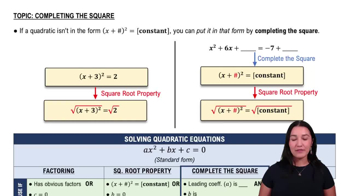Here are the essential concepts you must grasp in order to answer the question correctly.
Radical Simplification
Radical simplification involves rewriting a radical expression in a simpler form, often by factoring out perfect squares. For example, √24 can be expressed as √(4 × 6), allowing us to simplify it to 2√6, since √4 is a perfect square.
Recommended video:
Perfect Squares
Perfect squares are numbers that can be expressed as the square of an integer. Common perfect squares include 1, 4, 9, 16, and 25. Recognizing these numbers is crucial for simplifying radicals, as they help identify factors that can be taken out of the radical.
Recommended video:
Solving Quadratic Equations by Completing the Square
Prime Factorization
Prime factorization is the process of breaking down a number into its prime factors. For instance, the prime factorization of 24 is 2 × 2 × 2 × 3. This technique is useful in radical simplification, as it helps identify perfect square factors that can be simplified.
Recommended video:
 Verified step by step guidance
Verified step by step guidance Verified Solution
Verified Solution



 2:9m
2:9m